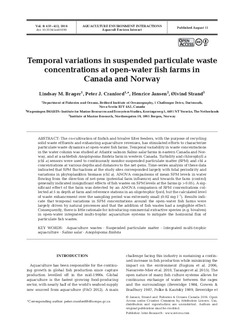| dc.contributor.author | Brager, Lindsay M. | |
| dc.contributor.author | Cranford, Peter J. | |
| dc.contributor.author | Jansen, Henrice M | |
| dc.contributor.author | Strand, Øivind | |
| dc.date.accessioned | 2020-01-17T07:45:28Z | |
| dc.date.available | 2020-01-17T07:45:28Z | |
| dc.date.created | 2020-01-16T14:04:46Z | |
| dc.date.issued | 2016 | |
| dc.identifier.citation | Aquaculture Environment Interactions. 2016, 8 437-452. | nb_NO |
| dc.identifier.issn | 1869-215X | |
| dc.identifier.uri | http://hdl.handle.net/11250/2636729 | |
| dc.description.abstract | The co-cultivation of finfish and bivalve filter feeders, with the purpose of recycling solid waste effluents and enhancing aquaculture revenues, has stimulated efforts to characterize particulate waste dynamics at open-water fish farms. Temporal variability in waste concentrations in the water column was studied at Atlantic salmon Salmo salar farms in eastern Canada and Norway, and at a sablefish Anoplopoma fimbria farm in western Canada. Turbidity and chlorophyll a (chl a) sensors were used to continuously monitor suspended particulate matter (SPM) and chl a concentrations at various depths and distances to the net-pens. Time-series analysis of these data indicated that SPM fluctuations at the study sites corresponded largely with tidal periodicity and variations in phytoplankton biomass (chl a). ANOVA comparisons of mean SPM levels in water flowing from the direction of net-pens (potential farm influence) and towards the farm (control) generally indicated insignificant effects of fish wastes on SPM levels at the farms (p > 0.05). A significant effect of the farm was detected by an ANOVA comparison of SPM concentrations collected at 5 m depth at farm and reference stations in an oligotrophic fjord, but the calculated level of waste enhancement over the sampling period was extremely small (0.02 mg l-1). Results indicate that temporal variations in SPM concentrations around the open-water fish farms were largely driven by natural processes and that the addition of fish wastes had a negligible effect. Consequently, there is little rationale for introducing commercial extractive species (e.g. bivalves) in open-water integrated multi-trophic aquaculture systems to mitigate the horizontal flux of particulate fish wastes. | nb_NO |
| dc.language.iso | eng | nb_NO |
| dc.title | Temporal variations in suspended particulate waste concentrations at open-water fish farms in Canada and Norway | nb_NO |
| dc.type | Journal article | nb_NO |
| dc.type | Peer reviewed | nb_NO |
| dc.description.version | publishedVersion | nb_NO |
| dc.source.pagenumber | 437-452 | nb_NO |
| dc.source.volume | 8 | nb_NO |
| dc.source.journal | Aquaculture Environment Interactions | nb_NO |
| dc.identifier.doi | 10.3354/aei00190 | |
| dc.identifier.cristin | 1774936 | |
| dc.relation.project | Norges forskningsråd: 228871 | nb_NO |
| dc.relation.project | Norges forskningsråd: 216201 | nb_NO |
| cristin.unitcode | 7431,12,0,0 | |
| cristin.unitname | Bentiske ressurser og prosesser | |
| cristin.ispublished | true | |
| cristin.fulltext | original | |
| cristin.qualitycode | 1 | |
